ISSN ONLINE(2319-8753)PRINT(2347-6710)
ISSN ONLINE(2319-8753)PRINT(2347-6710)
Mohd Abdul Haleem Abir1, Dr.A.Aruna kumari2, Dr.K.Vijaya Kumar Reddy3
|
| Related article at Pubmed, Scholar Google |
Visit for more related articles at International Journal of Innovative Research in Science, Engineering and Technology
The importance of energy and energy security is paramount. With alarming rate of depleting fossil fuels, rising crude oil prices, depreciating domestic currency and increasing oil imports, India stares at an acute prospect of having to incur huge foreign exchange outgo to buy expensive energy in the name of oil. Technology commands enormous power to effect major transformation. In conventional diesel engine approximately one-third of the fuel energy input is converted into useful work and the other major is rejected as heat via cooling system and exhaust gases. Moreover, this engine poses a major cause for automobile pollution. Epidemiological evidence that link auto-pollution to high human mortality rate is robust. This compels governments to stipulate stringent emission standards. Thus, decrease in fuel consumption, exhaust emissions without compromising efficiency is the prime factor. These challenges have generated impetus to researchers worldwide in the automotive field. The Thermal Barrier Coating (TBC) has been recognized as showing considerable promise for IC engines. TBCs are basically ceramic coatings with ultra low thermal conductivity deposited on engine components thereby making an insulated engine. This minimizes the heat transfer to the cooling system due to which it gets the name Low Heat Rejection (LHR) engine. Likewise, Bio-diesel too has a potential as a promising alternative fuel to their diesel counterparts while being renewable, sustainable, and environmental friendly. In this work, the comparative effect of performance and emission characteristics of a standard compression ignition engine (STD) and partially stabilized zirconia (PSZ) coated (LHR) engine are investigated. Air Plasma spray (APS) technique is utilized for deposition of PSZ on the piston crown of the test engine to a thickness of 175μm, while the bond-coat Al2O3 to 125 μm. Thereby making a 300μm thickness of TBC. The effect of Bio-diesel - Animal-Tallow-Methyl-Ester (ATME) on LHR engine is analyzed. The experimental work is carried out on 4-stroke, single cylinder, naturally aspirated, water cooled DI diesel engine. The results showed improved efficiency, fuel consumption and exhaust emissions except for NOx.
Keywords |
| Diesel engine, Thermal barrier coating, Bio-diesel, Exhaust emissions, LHR |
INTRODUCTION |
| TBCs play a crucial role in Internal Combustion engine systems because of their ability to significantly increase engine operating temperature with adequate back-side cooling, thus greatly help to achieve low emissions and high efficiency goals [1]. The earliest ceramic coatings were frit enamels developed by National Advisory Committee for Aeronautics (NACA) on exhaust nozzle of the X-15 manned rocket plane [2]. This revolutionized IC engines to operate in hostile environments where the working temperature can be as high as the melting point of the metals of combustion chamber [3]. Thus superficially coating the component, different properties are achieved viz. increase of working temperature, efficiency, reduced thermal loads, reduced heat transfer to the cooling system and increased exhaust gas temperature [4-6]. This insulation strategy by the use of TBCs was augmented to diesel engines by Kamo and Bryzik. They used thermally insulating materials such as silicon nitride for insulating different components of combustion chamber and reported an improvement of 7% in performance [7]. |
| Thermodynamics of LHR engine: The key behind the LHR engine is to recover the in-cylinder heat transfer to the cooling medium instead on the crankshaft as useful work, which results in substantial fuel economy and efficiency. This is satisfied by first law of thermodynamics. Second law of thermodynamics mandates no engine is 100% efficient, that is, the input energy cannot equalize the useful work output and some heat has to be rejected by the system, preferably at the lowest possible limit to gain the highest possible efficiency. This reduction of in-cylinder heat transfer to the cooling medium satisfies second law, moreover according to first law has the potential to do more work [8-9]. The energy can be recovered even as high exhaust gas temperature (EGT) due to insulation and can be harnessed or the process may be said „Compounding of EGT‟. Thus TBCs by insulation can offset the design parameters of cooling systems and substantially improve fuel consumption, efficiency and emissions of CI engines. These prospects gave a thrust to active researches in the field of LHR engines. According to Woschni G et al [10] from the thermodynamic point of view it would be much better to decrease the temperature levels of components not by more extensive cooling but by insulating the CC walls. Das et al [11] have conducted experiments by varying the thickness of coatings and reported improved results in diesel engines. However, the degree of insulation has some practical limitations. Xue J et al [12] have done an extensive research on papers published since year 2000 to 2011 and reported overwhelming researchers claim improvement in economy, efficiency and emissions by the use of LHR engines fueled with Bio-diesel. Bio-diesel has increased BSFC to compensate lower heating value, but this trend reverses when used in LHR engines due to increased in-cylinder temperatures and pressures. |
MATERIALS AND METHODS |
| An ideal ceramic coating material is expected to have following properties: (1) low thermal conductivity (k), (2) high melting point (Tm), (3) no phase transformation between room temperature and working temperature, (4) thermal expansion (α) match with metallic substrate and (5) good adherence to substrate. Because no single material satisfies all requirements for TBC, as a result coating system is evolved [13]. TBC is a dual layer of bond coat and ceramic top coat. The bond-coat creates a metallic bond between the substrate and the ceramic top coat to allow smooth transition which otherwise differ in physical properties. Ceramic top coat and bond coat are dynamic and interact to control performance [14]. The suitable deposition technique for CI engines which undergo cyclic loading and cyclic temperature is Air Plasma Spray (APS) which deposits TBC in molten splats resulting in characterized porosity [4, 15]. In this work PSZ as ceramic top coat with 175μm and Al2O3 with 125μm thickness are investigated. Table 1 gives the properties of the same. |
| Animal Tallow Methyl Ester (ATME) |
| Animal fat undergoes transesterification process to result into bio-diesel-ATME. Transesterification process enables bio-diesels to be usable in IC engines for conservation, management, efficiency and environmental preservation. This process also increases Cetane number to appreciable levels [16]. About 14 MT of ATME is produced globally. ATME as unique feedstock has certain properties that are hard to produce from plant oils [17]. The properties in comparison to diesel are listed in table 2. |
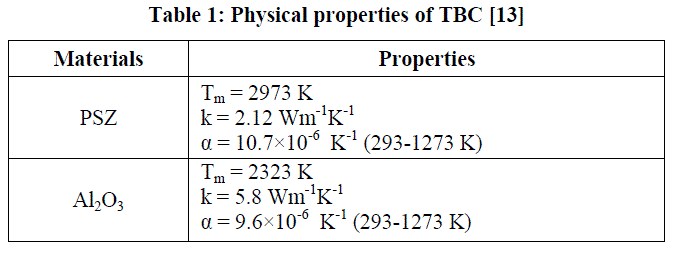 |
ENGINE TEST RIG |
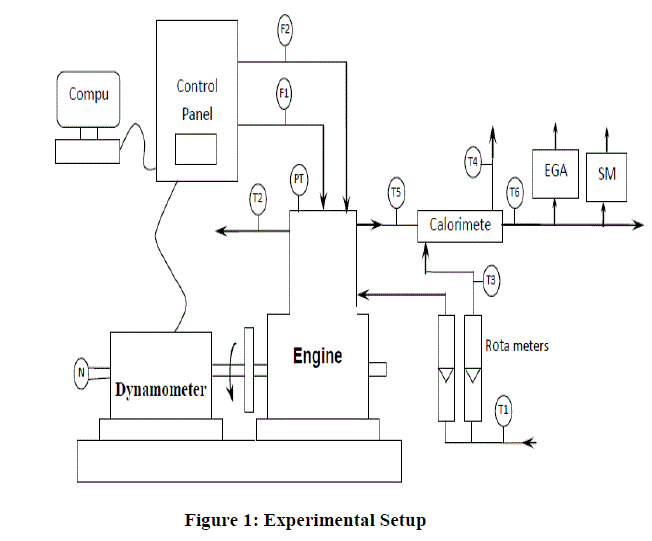 |
| The Kirloskar engine is one of the widely used engines in agriculture pump sets, farm machinery and medium scale commercial purposes. The engine specifications are shown in table 3. The setup consists of a single cylinder, four strokes, naturally aspirated, water cooled Diesel engine connected to eddy current dynamometer. This eddy current dynamometer is used for loading the engine. The engine is interfaced with Engine Soft Software for the measurement of combustion parameters. It is provided with necessary instruments for Combustion chamber pressure and crank-angle measurements. For the measurement of cylinder pressure, a pressure transducer is fitted on the engine cylinder head and a crank angle encoder is used for the measurement of crank angle and TDC position. The pressure and crank angle signals are fed to a data acquisition card fitted with Pentium 4 PC. The engine speed is sensed and indicated by an inductive pick up sensor in conjunction with a digital rpm indicator, this is a part of eddy current dynamometer. The liquid fuel flow rate is measured on the volumetric basis by a transmitter. Provision is also made for interfacing airflow, temperatures and load measurement. The airflow is measured using an orifice meter and the exhaust gas temperatures are recorded with thermocouples. The set up has stand-alone panel box consisting of air box, fuel tank, manometer, fuel measuring transmitter. Rotameters are provided for cooling water and calorimeter water flow measurement. The various components of experimental setup are shown in figure 1. |
 |
EXPERIMENTAL PROCEDURE |
| In this work, the engine is maintained at 1500 rpm throughout the experimentation and fixed injection pressure of 180 bar. The standard engine (STD) without coating is experimented at nine different loads in increasing order. For this, eddy current dynamometer is used. Emissions are recorded by Multi Gas Analyzer MN-05. To attain the steady state, engine is put to idling for 15min before every set of experimentation at minimum possible load. Then the STD engine‟s piston is uninstalled and replaced by PSZ coated piston. Then the same procedure is carried out. The modified engine (LHR) is compared for performance and emission characteristics with base line engine (STD) using both Diesel and ATME fuels. Performance characteristics are recorded by GUI software-Enginesoft by Apex technologies Ltd. In each set of test readings, fuel consumption, cylinder pressures at different crank angles, exhaust gas temperatures and concentrations of CO, CO2, HC, NOx emissions are taken at nine different loads. |
RESULTS AND DISCUSSIONS |
| This experimentation studies the effect of Bio-diesel and TBC individually as well as simultaneously. Bio-diesel when compared to diesel has lower heating value, higher viscosity and higher oxygen content with lower carbon to hydrogen ratio. TBCs increase the in-cylinder temperature by reducing heat transfer to cooling system or surroundings which increase the expansion work. The combined effects are thus worth experimenting. These results are visualized by graphs from figure 2 to figure 9. |
| Legend: |
| STD-Diesel - Experimentation of Standard (baseline) engine fueled with Diesel |
| STD-ATME - Standard engine fueled with Animal Tallow Methyl Ester |
| LHR-Diesel - Modified Low Heat Rejection engine or thermal-barrier-coated engine fueled with Diesel |
| LHR-ATME – Low Heat Rejection engine fueled with Animal Tallow Methyl Ester |
| A. Performance Parameters |
| Brake Thermal Efficiency: |
| Fig 2 shows the variation of Brake Thermal Efficiency with Brake Power. There is an improvement by 7% for coated engine fueled with ATME when compared to base line engine. This is attributed to high in-cylinder temperatures and pressures in coated engines which decrease viscosity, improve vaporization and atomization of biodiesel. Further, higher oxygen content and cetane number help in better combustion resulting in more expansion work. |
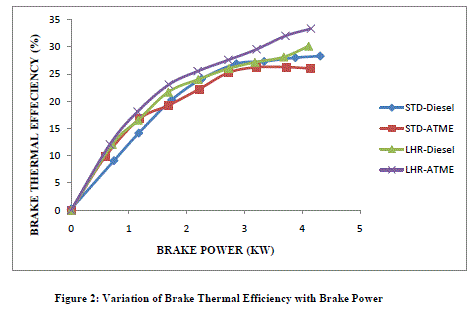 |
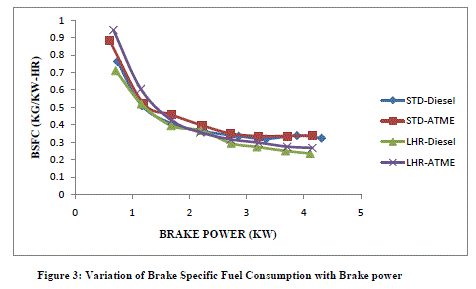 |
| Brake Specific Fuel Consumption: |
| Fig 3 shows the variation of BSFC with BP. It is inferred that coated engine powered with diesel has the lowest fuel consumption. This is due to higher temperature of combustion chamber walls which atomize fuel issuing from the injector completely and reduce quenching distance yielding lower fuel consumption. LHR-ATME has lower BSFC than the baseline engine. Shrirao et al [19] report improved BSFC by a turbocharged LHR engine. The effect of injection pressure and injection timing are crucial for Bio-diesels for improving BSFC which needs further investigations. Compounding of EGT has potential to improve BSFC significantly. |
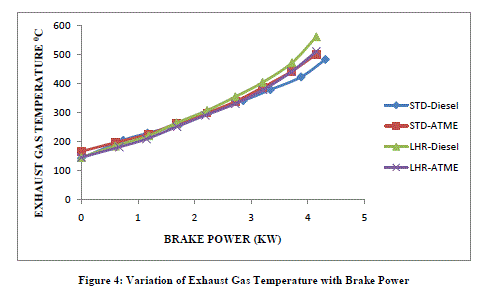 |
| Exhaust Gas Temperature: |
| Fig 4 shows the variation of EGT with BP. Due to insulation strategy by LHR engine much of the heat transfer which is reduced to cooling system is recovered as exhaust energy. This is credited for increased EGT in LHR engines compared to standard engines |
| B. Emission Characteristics |
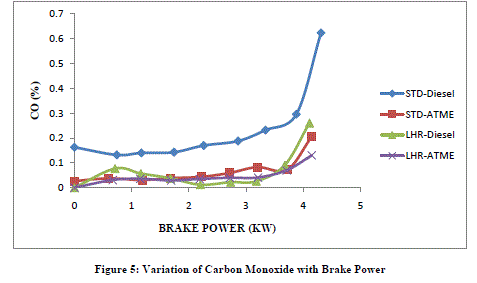 |
| Carbon Monoxide Emissions: |
| Fig 5 interprets the variation of CO with BP and substantiates the potential of LHR engines. It is well known that better combustion leads to lower concentrations of CO at the exhaust. The trend increases with increase in load as air-fuel ratio decreases by increase in load. LHR-ATME has least CO concentration and is startlingly much lower than the baseline engine. This is due to complete combustion in insulated environment of LHR engine and high oxygen content in bio-diesels. Further, ATME has high cetane number which reduces the possibility of formation of rich fuel zone which diminishes CO formation. This may also be attributed to lower carbon to hydrogen ratio in bio-diesels. |
| Carbon Dioxide Emissions: |
| Fig 6 shows the variation of CO2 with BP. CO2 emitted is proportional to fuel consumption. LHR-ATME has lower CO2 concentration compared to baseline engine due to lower fuel consumption as is evident from fig 3. This may also be attributed to lower carbon content in bio-diesels. |
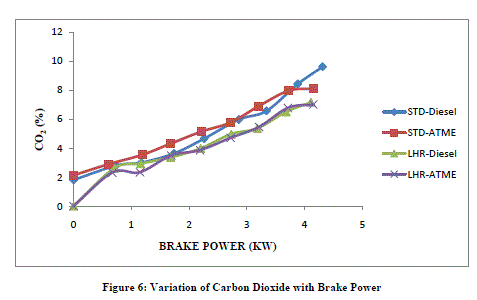 |
| HC Emissions: |
| Fig 7 shows the variation of HC with BP. HC emission is reduced in LHR-ATME engine due to high after combustion temperatures and stresses which engulf any remaining unburned HC into the combustion process, thereby leaving little possibility of sac volume formation. In bio-diesels this may be due to high cetane number which decreases the quenching distance in high in-cylinder temperature environment of LHR engine. |
| NOx Emissions: |
| Fig 8 shows the variation of NOx with BP. NOx is temperature sensitive. The high combustion temperatures, inherent availability of nitrogen and oxygen from fuel and intake charge create favorable conditions in accelerating the reaction to result into oxides of nitrogen. This is the reason for increased NOx concentrations in LHR engine. In bio-diesels, higher oxygen content increases injection advance thereby increasing chances for NOx formation. The trend for NOx at high loads is decreasing. This may be attributed to reduced residence time at top loads where peak pressures are attained. |
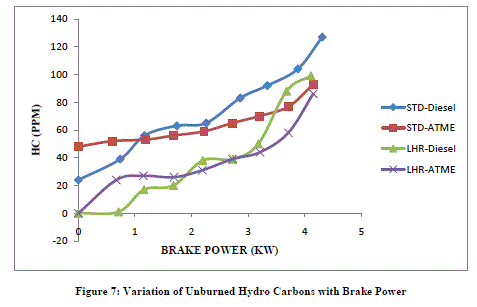 |
| C. Combustion Characteristics |
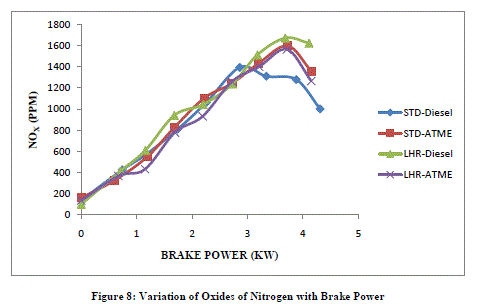 |
| Pressure Vs Crank angle variation: |
| Figure 9 visualizes variation of in-cylinder pressures with crank angles. For standard engine the peak pressure is about 81 bar while for its counterparts LHR-Diesel and LHR-ATME maintained a pressure of 86 and 87.5 bar respectively. This is due to the insulation technique of LHR engines and high O2 contents of bio-diesel fuels, which increase the in- cylinder working temperatures and help in complete combustion thereby increasing the expansion work which boosts cylinder pressure. |
CONCLUSIONS |
| In this work, conventional diesel engine is converted to thin ceramic coated LHR engine. The combined effect of coated engine powered with bio-diesel (ATME) is studied for performance and emission characteristics. The following conclusion can be drawn: |
| i. PSZ coatings make the engine semi-adiabatic. This increases in-cylinder after combustion temperature that lead to more expansion work thus increasing Brake Thermal Efficiency significantly. |
| ii. Due to more oxygen content and high cetane number, bio-diesel under LHR engines enhances complete combustion and thus has the potential to replace diesel fuel. |
| iii. By reducing the heat transfer to cooling medium, exhaust energy is increased. This can be turbo compounded to run power-turbines or turbochargers in the downstream. This can improve BSFC and efficiency significantly. |
| iv. Due to complete combustion at high temperatures, exhaust emission concentrations are diminished drastically. Exhibits eco-friendly system. |
| v. In LHR engines NOx concentrations alone are high. Nevertheless, this can be controlled by catalytic converter which needs high temperatures for operation and this is readily available from EGT. |
| vi. Thus LHR engines and bio-diesels coupled can solve the conflict between economic development and preservation of human health. |
ACKNOWLEDGEMENT |
| The authors sincerely thank Department of Mechanical Engineering, JNTU College of Engineering Hyderabad for support, co-operation and encouragement that enabled this experimental work in IC engines. Authors wish to thank Sri Sai Surface Coatings Pvt. Ltd., Hyderabad for coating requirements. Authors are also grateful to Southern Online Bio- Technologies Pvt. Ltd., Hyderabad for providing bio-diesel. |
References |
|